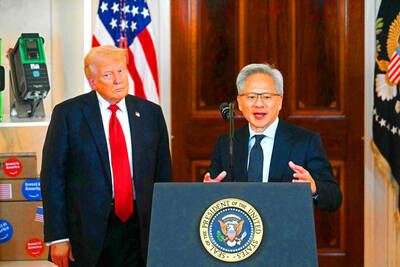The official Purchasing Managers’ Index (PMI) last month climbed for a third consecutive month to 54.9, another encouraging sign that the nation’s manufacturing sector is stabilizing, the Chung-Hua Institution for Economic Research (CIER, 中華經濟研究院) said yesterday.
The PMI inched up 0.3 percentage points last month from 54.6 in April, continuing to stay above the threshold of 50 in a sign of expansion, the Taipei-based institute’s statistics showed.
“The uptrend over the past three months gives us stronger confidence that the manufacturing sector is stabilizing,” CIER president Wu Chung-shu (吳中書) told reporters at a news conference.
Employment was a main driver of last month’s PMI growth, with a solid gain of 4.1 percentage points to 54.1, Wu said.
Among key sub-indicators, new orders and imports increased 0.6 and 2.8 to 58 and 54.5 respectively, marking a third month of expansion for both, the data showed.
However, CIER said that it was concerned by a sudden dip in the six-month outlook sub-index.
The index fell 4.3 to 56.7 last month after seven consecutive months of increases, Wu said.
“Last month’s improvement is very partial and only limited to information-technology and electronics companies,” Wu said. “Some orders are supported by inventory restocking demand... Not a single company tells me they are confident that a recovery will come soon.”
Some semiconductor companies said they have received orders for Apple Inc’s iPhone 7 model, but order visibility is low on doubts over any new and exciting features that would stimulate replacement demand, CIER said.
The institute said it expects it will take a longer time for Taiwan to start seeing a substantial recovery from an “L-shape” rebound, compared with a “V-shape” revival from the last recession during global 2008 to 2009 financial crisis.
However, the Markit PMI yesterday said the sector was worsening as the index slipped again to 48.5 last month from 49.7 in April.
That signaled a deterioration in the health of the sector for the second month in a row, marking the fastest decline since October last year, the London-based company said in a separate report.
“Taiwanese manufacturers reported a sharper deterioration in overall business conditions in May, with output and new orders both contracting at faster rates than in April,” Markit economist Annabel Fiddes wrote in a statement.
Meanwhile, non-manufacturing indices (NMI) showed a second month of contraction last month, with the decline accelerating 0.9 percentage points to 47.9, CIER said.
It was unusual to see the NMI differ from the PMI, CIER said.
A decline in Chinese tourists is a factor to monitor over the next few months, the institute said.
Complaints from the tourism sector showed that the number of Chinese tourists began to fall rapidly last month after President Tsai Ing-wen (蔡英文) took office, CIER said.
The six-month outlook sub-index for the non-manufacturing sector shrank 4.1 to 36.4 last month, extending the bearish view of the past 12 months.
Commenting on possible monetary policy adjustments at the central bank’s next board meeting later this month, Wu said the bank might still consider monetary easing to boost the economy.
“Taiwan is facing weakness in external and internal demand,” Wu said.

Taiwan Semiconductor Manufacturing Co (TSMC, 台積電) last week recorded an increase in the number of shareholders to the highest in almost eight months, despite its share price falling 3.38 percent from the previous week, Taiwan Stock Exchange data released on Saturday showed. As of Friday, TSMC had 1.88 million shareholders, the most since the week of April 25 and an increase of 31,870 from the previous week, the data showed. The number of shareholders jumped despite a drop of NT$50 (US$1.59), or 3.38 percent, in TSMC’s share price from a week earlier to NT$1,430, as investors took profits from their earlier gains

AI TALENT: No financial details were released about the deal, in which top Groq executives, including its CEO, would join Nvidia to help advance the technology Nvidia Corp has agreed to a licensing deal with artificial intelligence (AI) start-up Groq, furthering its investments in companies connected to the AI boom and gaining the right to add a new type of technology to its products. The world’s largest publicly traded company has paid for the right to use Groq’s technology and is to integrate its chip design into future products. Some of the start-up’s executives are leaving to join Nvidia to help with that effort, the companies said. Groq would continue as an independent company with a new chief executive, it said on Wednesday in a post on its Web

CHINA RIVAL: The chips are positioned to compete with Nvidia’s Hopper and Blackwell products and would enable clusters connecting more than 100,000 chips Moore Threads Technology Co (摩爾線程) introduced a new generation of chips aimed at reducing artificial intelligence (AI) developers’ dependence on Nvidia Corp’s hardware, just weeks after pulling off one of the most successful Chinese initial public offerings (IPOs) in years. “These products will significantly enhance world-class computing speed and capabilities that all developers aspire to,” Moore Threads CEO Zhang Jianzhong (張建中), a former Nvidia executive, said on Saturday at a company event in Beijing. “We hope they can meet the needs of more developers in China so that you no longer need to wait for advanced foreign products.” Chinese chipmakers are in

POLICY REVERSAL: The decision to allow sales of Nvidia’s H200 chips to China came after years of tightening controls and has drawn objections among some Republicans US House Republicans are calling for arms-sale-style congressional oversight of artificial intelligence (AI) chip exports as US President Donald Trump’s administration moves to approve licenses for Nvidia Corp to ship its H200 processor to China. US Representative Brian Mast, the Republican chairman of the US House Committee on Foreign Affairs, which oversees export controls, on Friday introduced a bill dubbed the AI Overwatch Act that would require the US Congress to be notified of AI chips sales to adversaries. Any processors equal to or higher in capabilities than Nvidia’s H20 would be subject to oversight, the draft bill says. Lawmakers would have